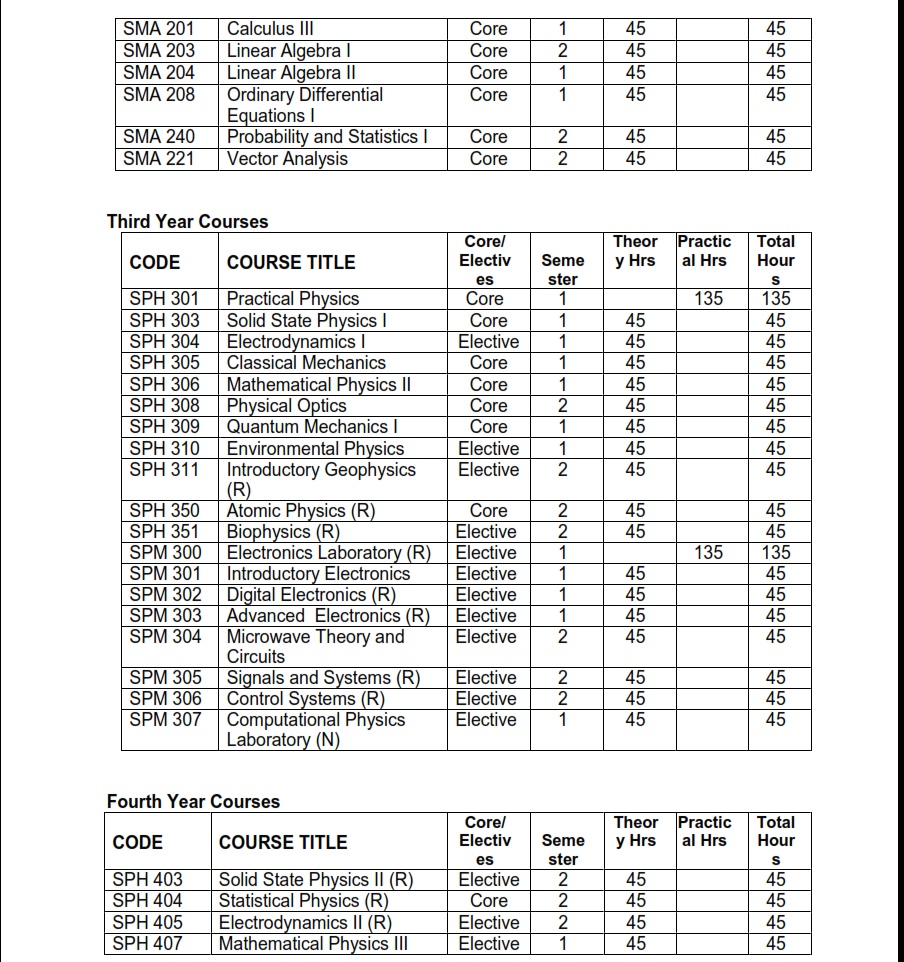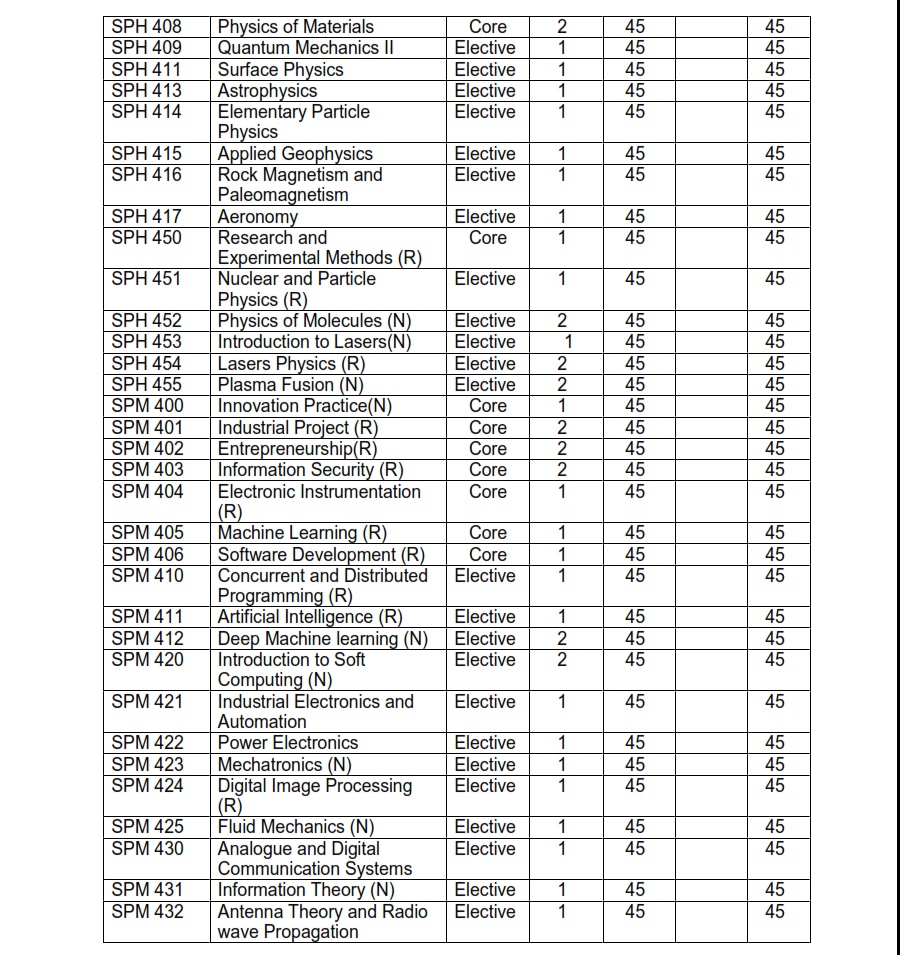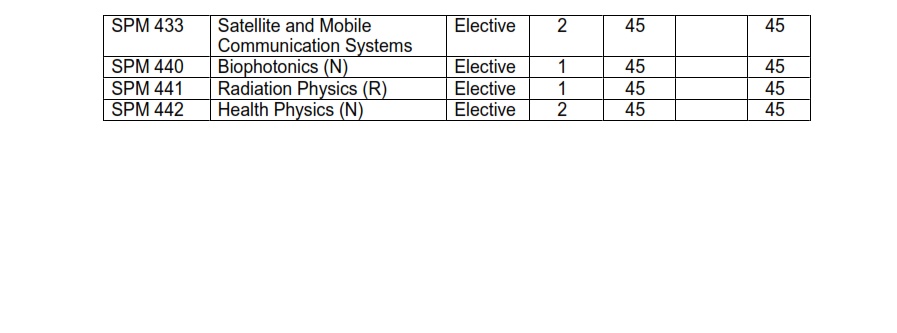Overview
Philosophy of the Programme
The philosophy of the programme is to foster excellence in creativity and innovation, academic freedom, professionalism and integrity through quality scholarly and research.
Rationale of the Programme
Cognizant of the transformative power of Science and technology, there is need to train highly motivated and competent manpower capable of addressing any emerging issues and innovations in the spectrum of information, science and technology.
The situational analysis undertaken by members of the department has resulted into consultations with experts within and outside the University. This culminated into a successful stakeholders’ workshop on the revision of the programme. The programme will provide leadership in innovation in the region for the benefit of the society and industry and further meet the societal needs such as in teaching, research laboratories, medical, industry, undertaking postgraduate studies and address new emerging issues related to information, science and technological innovations. The programme is envisaged to create employers and employable graduates in both formal and informal sectors.
Goal of the Programme
The goal of the programme is to train high-level and competent personnel with the relevant knowledge and refined skills in microprocessor technologies and instrumentation and related applications that is necessary for scientific innovations capable of making transformative contribution to the world of science, information and technology and further addressing societal challenges of industrial and human resource development for the betterment of humanity.
Expected Learning Outcomes of the Programme
By the end of the programme, the learner should be able to:
- Demonstrate architectural modelling, mathematical modelling, programming and electronic construction skills in problem solving.
- Demonstrate oral, written and visual communication skills in problem solving.
- Select and apply the different knowledge domains and types, plans and methods required during problem solving and system development.
- Theorise, analyse, model and simulate physical systems.
- Experiment on physical systems
- Construct, program and test electronic, programmable, learning and cyber-physical systems.
MODE OF DELIVERY
The programme is offered through both Face to Face and by Open, Distance and e-Learning (ODeL) mode of learning
Face to Face mode of Learning
This delivery mode shall use face to face full time learning through:
- Lectures and tutorials with lecture notes, LCDs, Whiteboards/black boards Instruction Materials and equipment
- Group discussions amongst learners
- Class experimental demonstration/simulation
- Practical laboratory work with laboratory manuals as course materials
Open, Distance Learning, and e-Learning (ODeL)
The Open, Distance and Electronic learning modules are largely home and /or office-based and include:
- Written self-instructional study modules issued at registration time, for example:
- Study course materials like booklets
- Relevant literature
- Interactive devices and self-tests
- Face to face introductory tutorials.
- Mediated technical learning materials for example:
- Audio visual
- E-learning
- Limited face-to-face sessions to provide overview of the course at commencement of semester, mid semester and revision period before examinations.
- Support study centers at the University of Nairobi
- Access to information through computers at the University of Nairobi and other resource centers.
- Use of libraries at the University of Nairobi and other institutions
- Orientation:
- Orientation on ODeL delivery
- Study, reading and computer skills
- Time management and techniques of handling assignments
- Mentorship, guidance and counselling
- Emphasis is on satellite centers that serve as a link between the University and the learner in the following manner: registration, collecting reading materials, collecting results and programmes, examination information, posting timetables and holding meetings.
ATTACHMENT OPPORTUNITIES
Physics students and graduates have attachment opportunities in the following sectors of the economy
- Energy sector such as Kenya power and lighting company (KPLC), Kenya power generating companies (such as Olkaria etc)
- Telecommunications and IT industry
- Satellite Space Stations (e.g., San Marco in Malindi)
- Aviation Industry such as Kenya Airways.
- Government agencies such as the Ministry of Public Works (Materials Branch), Kenya Bureau of Standards (KEBS), Kenya Industrial Research Development institute (KIRDI), Kenya Intellectual Property Institute (KIPI).
Contact Person
For more information, contact
The Chairman,
+254794587955, +254204924119
Structure




Duration of the program
The program shall normally run for four (4) academic years (8 semesters). Common University regulations shall apply. Maximum duration of the course shall be eight (8) years. The Open, Distance and eLearning programme will run for a minimum of 4 years and a maximum of 8 years.
Structure of the Programme
- In the first year of study, each learner will be required to take fourteen (14) units which are inclusive of three (3) university common courses.
- In the second year of study, each learner will be required to take thirteen (14) units.
- In the third year of study, candidates will be expected to undertake at least total of 14 approved courses covering various Physics, Electronics and computing courses leading to the following options given in Table 2.6.
- Applied Physics
- Computing
- Industrial Electronics
- Biomedical and Radiometric Instrumentation
- Telecommunications
The course distribution summary as well as specialization options are given below in Tables 2.2-2.6.
- In the fourth year of study, each learner will be required to take fifteen (15) units with choices for each area of specialization guided by the specialization options given in Table 2.6. SPM 400 (Innovation Practice) is in lieu of attachment.
Admission Requirements
-
A candidate wishing to register for a Bachelor of Science degree in Microprocessor Technology and Instrumentation must have attained the minimum University of Nairobi and School of Physical Sciences entry requirements. In addition, the candidate must have any of the following:
- Kenya Certificate of Secondary Education (KCSE) or equivalent qualifications recognized by the University of Nairobi Senate, with minimum mean grade of C+ (C Plus) and C+ (C Plus) passes in at least three science subjects two of which must be mathematics and physics.
- Kenya Advanced Certificate of Education (KACE) or equivalent qualification with at least two principal passes in mathematics and physics subjects.
- Diploma in a relevant field from an institution recognized by the Senate.
- A science/technology based degree or its equivalent from an institution accredited by the Commission for University Education.
- Candidates who may not have fulfilled conditions in (i) above may be considered for admission provided they present evidence of having undertaken and passed relevant bridging courses from an institution recognized by the University and MUST have scored a minimum mean grade of C+ (C plus) and at least grade C in the subject(s) for which bridging has been undertaken.
Careers
This programe provides an avenue for graduate studies in the areas of Advanced Technology for electronic devices and new materials and its applications in business, industry and scientific microprocessor based instrumentation. Graduates have opportunities in:
- Applied Physics
- Computing and IT industry
- Industrial Electronics
- Biomedical and Radiometric Instrumentation
- Telecommunications
Fees and Funding
| BACHELOR OF SCIENCE IN MICROPROCESSOR TECHNOLOGY & INSTRUMENTATION - I39 | |||
| YEAR 1 -12UNITS | |||
| Semester 1 | Semester 2 | TOTALS | |
| TUITION | 144,000 | 144,000 | 288,000 |
| EXAMINATION (PER UNIT @1000) | 6,000 | 6,000 | 12,000 |
| REGISTRATION (PER SEMESTER@2250) | 2,250 | 2,250 | 4,500 |
| ID CARD ( PER YEAR) | 1,000 | 0 | 1,000 |
| ICT SERVICES - (PER YEAR) | 7,000 | 7,000 | |
| CAUTION - (ONCE) | 5,000 | 5,000 | |
| MEDICAL FEE (PER YEAR) | 6,500 | 6,500 | |
| STUDENT ORGANISATION(PER YEAR) | 1,000 | 1,000 | |
| ACTIVITY-( PER YEAR) | 2,000 | 2,000 | |
| LIBRARY (PER YEAR) | 4,000 | 4,000 | |
| Total-Microprocessor-Year 1 | 178,750 | 152,250 | 331,000 |
| YEAR 2 -12UNITS | |||
| Semester 1 | Semester 2 | TOTALS | |
| TUITION | 144,000 | 144,000 | 288,000 |
| EXAMINATION (PER UNIT @1000) | 6,000 | 6,000 | 12,000 |
| REGISTRATION (PER SEMESTER@2250) | 2,250 | 2,250 | 4,500 |
| ID CARD ( PER YEAR) | 1,000 | 1,000 | |
| STUDENT ORGANISATION(PER YEAR) | 1,000 | 1,000 | |
| ICT SERVICES - (PER YEAR) | 7,000 | 7,000 | |
| MEDICAL FEE (PER YEAR) | 6,500 | 6,500 | |
| LIBRARY (PER YEAR) | 4,000 | 4,000 | |
| ACTIVITY-( PER YEAR) | 2,000 | 2,000 | |
| Total-Microprocessor-Year 2 | 173,750 | 152,250 | 326,000 |
| YEAR 3 -12UNITS | |||
| Semester 1 | Semester 2 | TOTALS | |
| TUITION | 144,000 | 144,000 | 288,000 |
| EXAMINATION (PER UNIT @1000) | 6,000 | 6,000 | 12,000 |
| REGISTRATION (PER SEMESTER@2250) | 2,250 | 2,250 | 4,500 |
| ID CARD ( PER YEAR) | 1,000 | 1,000 | |
| STUDENT ORGANISATION(PER YEAR) | 1,000 | 1,000 | |
| ICT SERVICES - (PER YEAR) | 7,000 | 7,000 | |
| LIBRARY (PER YEAR) | 4,000 | 4,000 | |
| MEDICAL FEE (PER YEAR) | 6,500 | 6,500 | |
| ACTIVITY-( PER YEAR) | 2,000 | 2,000 | |
| Total-Microprocessor-Year 3 | 173,750 | 152,250 | 326,000 |
| YEAR 4 -12UNITS | |||
| Semester 1 | Semester 2 | TOTALS | |
| TUITION | 144,000 | 144,000 | 288,000 |
| EXAMINATION (PER UNIT @1000) | 6,000 | 6,000 | 12,000 |
| REGISTRATION (PER SEMESTER@2250) | 2,250 | 2,250 | 4,500 |
| ICT SERVICES - (PER YEAR) | 7,000 | 7,000 | |
| LIBRARY (PER YEAR) | 4,000 | 4,000 | |
| STUDENT ORGANISATION(PER YEAR) | 1,000 | 1,000 | |
| ID CARD ( PER YEAR) | 1,000 | 1,000 | |
| MEDICAL FEE (PER YEAR) | 6,500 | 6,500 | |
| ACTIVITY-( PER YEAR) | 2,000 | 2,000 | |
| Total-Microprocessor-Year 4 | 173,750 | 152,250 | 326,000 |
| Grand TOTALS | 1,309,000 | ||
